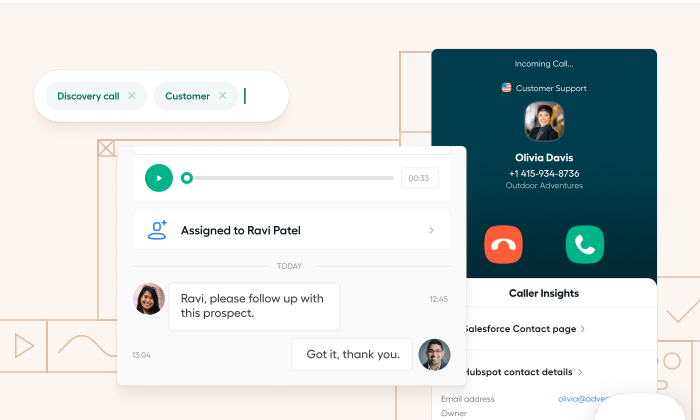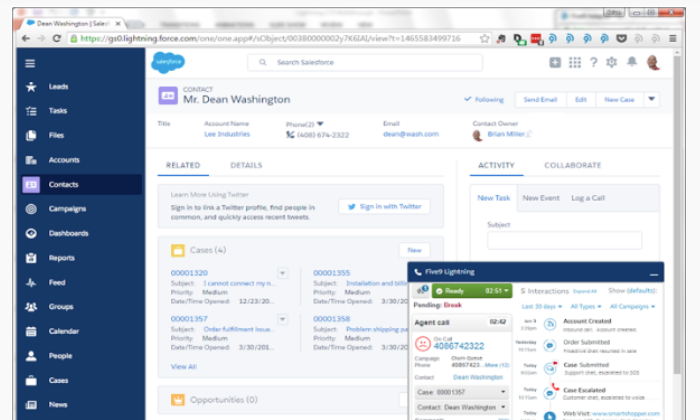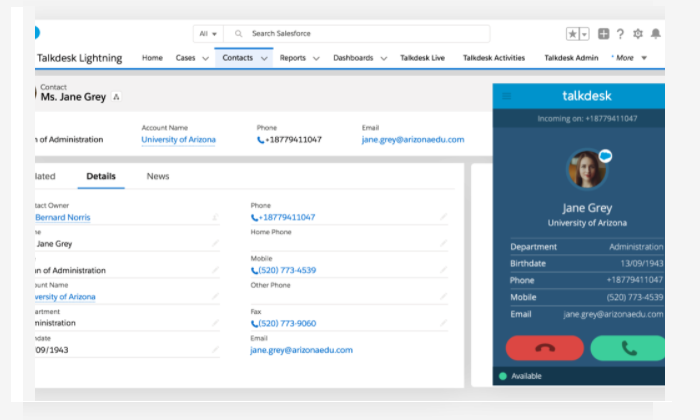
Disclosure: This content is reader-supported, which means if you click on some of our links that we may earn a commission.
Nothing scares away new business like hard-to-reach customer service or disorganized sales calls.
By adopting the best call center software, you can outfit your teams with the tools they need to communicate effectively. And it won’t cost that much at all so long as you have a good internet connection.
Forget about the requirements of a physical office space, infrastructure, or even a business phone system.
Modern call center software is all you need to get up and running. You still have the hard work of engaging your customers and clients, but all the heavy lifting associated with maintaining a call center is off your plate.
Read on for in-depth reviews of my top picks. I’ll talk about what they offer and the types of businesses they work well for. After the reviews, I’ve included a brief guide to help you evaluate these good options and find the one that’s best for you.
#1 – Five9 — Best For Blended Call Centers
Five9 empowers call center agents to deliver the best possible experience to their customers by providing true omnichannel functionality from anywhere within an intuitive interface.
Agents can switch between chat, email, mobile, social, video, or voice to maintain seamless customer interactions.
Plus, integrations with top CRM platforms mean that all data is captured, providing an end-to-end contact center solution. Whether agents are reaching out or picking up a call, they always have current information about who they’re speaking with.

There are also built-in workforce management tools that make accurate forecasting and scheduling much easier.
For all the power of Five9 call center software, it’s not overwhelming, and people can quickly master the tools at their disposal, such as:
- Predictive, power, progressive, and preview dialers
- Intelligent omnichannel routing
- IVR
- Historic and real-time analytics dashboards
- Six built-in CRM integrations
- Cloud APIs and SDKs
Blended call centers will definitely notice increased efficiency using Five9. Active blending, one of the intelligent routing features, automatically sends inbound calls to agents working outbound campaigns when call volume is high.
Five9 pricing is based on whether you want inbound, outbound, or blended service. You’ll have to get in touch with sales, but there are three options for how to pay:
- Monthly on-demand
- Per-minute fees
- Annual contracts
The lowest price will come with an annual contract, but companies can scale quickly at low cost with on-demand pricing if need be.
As sleek as it is, Five9 is one of the top call center solutions for companies that need to integrate legacy technology. If you’re thinking about using a cloud-based solution for your blended call center, Five9 can help no matter where you are starting from.
#2 – Aircall — Best For Collaboration
Aircall is a CCaaS (Call Center as a Service) you can deploy this afternoon.
The VoIP quality is great, calls don’t drop, and agents can work from anywhere on their laptop or personal mobile device. It’s a great solution for virtual cloud call centers because of the built-in security, workforce management, and collaborative features.
Customers can leave voicemails which can be quickly assigned to the right person. New hires can listen into calls to hear what good service sounds like. In fact, you can host up to five people on the same live call.

One of the biggest perks for teams is the ability to assign, tag, and comment on calls. This is so helpful—assign the call to an individual, tag it to a specific department, and leave a short explanation about what’s going on.
It’s not that other call center software can’t do this. It’s just easier in Aircall.
For all the ease of using Aircall, it is a complete CCaaS that provides
- Automatic call-back
- Intelligent call routing
- IVR
- Power dialer
- One-click CRM integrations
- Call center analytics
Aircall pricing is broken down into three tiers:
- Essentials: starting at $30 per user/month
- Professional: starting at $50 per user/month
- Custom: contact sales
One quick thing: Salesforce integration only comes at the Professional tier, whereas integrations for Pipedrive, Zendesk, Hubspot, Slack and more than 60 others come with Essentials.
Aircall still supports traditional phone systems, which makes it an attractive option for companies that want to expand their call center operations to the cloud at their own pace.
#3 – 8×8 Contact Center — Best For Enterprise
8×8 Contact Center is one of the more robust tools on the market. 8×8 has been around for a long time and can fully support migration to a UCaaS (Unified Communications as a Service) contact center.
All communications—voice, video, talk, text, chat, for internal and external use—are centralized in the 8×8 Contact Center platform.
It’s a powerful solution that can help large organizations in particular. Build out complex IVR paths, optimize a large workforce, and process payments all within a navigable interface.

There may be a little more of a learning curve with 8×8 than with other call center software simply because the platform is so feature rich.
That said, once you have everything set up, the support and online documentation is enough to help people take advantage of 8×8’s advanced features, including:
- Call and screen recording
- Predictive dialer
- Drag-and-drop IVR designer
- Speech analytics
- Customer surveys
- Native CRM and integrations with top products
The pricing for 8×8 Contact Center breaks down into three tiers:
- Contact Center – Voice
- Contact Center – Omnichannel
- Contact Center – Advanced
8×8 is not going to be the most budget-friendly option, even at its voice-only tier.
To include digital channels, you will need the Omnichannel plan. For speech analytics and screen recording, you will need Advanced.
For voice-only call centers, other options from this list will meet your needs at a lower cost. If you are trying to build out an omnichannel contact center, however, 8×8 will give you a level of visibility and control that lighter products can’t.
#4 – Dialpad — Best For Startups
Dialpad is a next-generation UCaaS that completely supports today’s on-the-go, distributed workplace. Choose Dialpad for agile, constantly improving call center software.
You can add agents via the web client or Dialpad app. Both are updated frequently for security and to add new features.
For all the flexibility provided to end-users, Dialpad doesn’t skimp on the backend reporting, recording, or monitoring features. This is huge for companies that are still trying to figure out what’s important.

With Dialpad, your team can assess KPIs and discover meaningful trends in real-time. Simply integrate your CRM and watch as Dialpad surfaces the most important metrics from calls on clean dashboards or highly-visible leaderboards.
Some of the other great capabilities of Dialpad include:
- IVR
- Seamless mobile routing
- Call/Voicemail transcription
- Warm transfer
- APIs and webhooks
- Integrations with top SSOs, CRMs, G Suite, and Microsoft 365,
There are two plan options for Dialpad Contact Center:
- Pro: starting at $225/month for 3 agents
- Enterprise: contact sales, 100 agent minimum
Businesses thrive with Dialpad because of its efficiency. Deployment is simple, integrations are tight, and it performs extremely well for organizations with many remote workers.
#5 – Talkdesk CX Cloud — Best For Salesforce Integration
Talkdesk is a leading CCaaS product that works well for large organizations who need to scale their contact center operations. Quickly provision new agents and securely connect them to sensitive customer data, no matter where they are.
It’s a feature-rich, yet very approachable, solution. People who have never used Talkdesk can sit down and start taking calls.
Talkdesk has more than 60 integrations ready to go, but the seamless connection with Salesforce CRM is definitely a key selling point. Agents can see a rich history of who they are talking to and all calls are automatically recorded in the proper place.

When agents forget call details, they can listen back with a few clicks.
Some tasks, like creating new IVRs, take some getting used to, but for the most part, non-technical users are going to be able to get the most out of every feature, including:
- Intelligent routing
- Warm transfer
- Customer sentiment surveys
- Real-time dashboards for workforce management
- Custom IVR
- Guardian Standard fraud prevention
Talkdesk also offers AI-driven add-ons for speech analytics, workforce management, and quality control.
Talkdesk has rolled out affordable solutions for SMB call centers. Adopting something this powerful early on will deliver superior customer engagement, and may even cut down on costs by increasing agent productivity.
What I Looked at to Find the Best Call Center Software
I make calls when I’m thinking about committing to a new product or service. Lots of people do.
The human connection is real, intimate, and—unfortunately—easy to mess up.
One dropped call. One mistaken name from an agent who’s spoken to 35 other people within the hour.
It doesn’t take much to lose a lead or earn a 1-star review carved in digital stone on the internet.
You’re looking for a system that establishes trust with customers because they know they can call and speak with the right person quickly.
It must also come with an interface that empowers agents by giving them insight into calls, client histories, and any other information they need to resolve issues in real-time.
Customers need prompt answers from helpful agents. End of story.
The best call center software comes with everything you need to meet these two fundamental call center objectives, and much more.
Let’s go through the core call center features that help businesses make their customers happier and their agents more productive.
Calling Capabilities
Blended call center software will let the same agent receive incoming calls and make outgoing calls. This isn’t the case with every product, as some are limited to a single direction: inbound or outbound.
This can work to your advantage.
If you only need one or the other, you may be able to get a less expensive plan that’s easier to secure and manage. A helpdesk might only need inbound and a sales team might be fine with outbound calls only.
Dialing Capabilities
For outbound call centers, having the right dialing capabilities can make a huge difference in terms of agent productivity (and sanity). The four types you are likely to see are:
- Preview dialer: Lets an agent review contact information before they call
- Progressive dialer: Automatically dials one contact per available agent
- Power dialer: Automatically dials multiple contacts per available agents
- Predictive dialer: Automatically dials based on predicted agent availability
Dialers decrease an agent’s down-time considerably and completely eliminate the manual grind process of making calls from their cognitive workload.
Channels
Call center software should be able to accommodate every channel you currently use or plan to use in the future. If you see something billed as omnichannel, it should cover:
- Phone
- VoIP
- SMS
- Chat
- Social
- Video
Ensure that whatever product you choose will let customers interact seamlessly with agents across all supported company channels.
Call Routing
Call center software comes with routing features that segment and direct incoming calls, potentially automating the processes which connect callers with the expert or agent they seek.
Some of the popular call routing features explained:
- Automatic Call Distribution (ACD): Greets customers and allows them to select from a main menu or enter extension to route themselves.
- Automated attendant: Takes calls when all agents are busy, plays hold music, relays wait times, and reminds callers that their time is valuable.
- Intelligent call routing: Uses automation, AI, or interactive voice response to route customers to the most appropriate agent.
- Mobile device routing: Allows calls to be routed to mobile devices.
- Omnichannel routing: Allows calls to be routed across any channel.
- Virtual hold: Gives customers the option to receive a call back when an agent is ready, instead of waiting on the phone.
- Warm transfer: Lets customers speak to a new agent before the call is transferred, and allows the previous agent to explain any ground that’s already been covered.
If call center software comes with intelligent call routing, it’s safe to assume it can handle most, if not all, of the capabilities listed above.
Interactive Voice Response
Interactive voice response (IVR) enables customers to use a phone system to access information from a connected database. This could be someone calling to find out their checking balance, hear the status of their order, or pay a bill.
If you have customers routinely calling to access information, you can free up a lot of phone time simply by implementing IVR. It’s a truly self-service solution that helps people get what they want, without ever talking to an agent.
Call Recording
You have probably heard a thousand times that “this call is being recorded for safety, security, or training purposes.” Well it’s all true.
Call recording is extremely important. Supervisors can listen back to trainee calls and give advice about how to improve. In the event of a legal or compliance issue, call recording will cover your bases.
Good call center software makes it as easy as possible to save and store every call in a highly organized, searchable database. If you integrate your CRM, every recording can also be tied to the appropriate customer or client account.
One advanced call recording feature that can be really useful for sales teams is voicemail-to-email. This sends an email with an audio attachment or transcription of the voicemail to the account owner who missed the call.
This is a huge time saver, especially for agents who are remote and on the go.
Workforce Management
How efficient is your call center? How do you know?
Reporting and analytics are important features of modern call center software. Look for products with both historical and real-time reporting capabilities to support workforce management and optimization.
By tracking key metrics about calls, wait times, and first contact resolution, among others, those in supervisory roles are better able to forecast staffing needs to fit fluctuating demand.
Integrations, APIs, and SDKs
Put key customer data in front of your agents by integrating customer data sources with your call center software. The top products come with seamless integrations that work out of the box with leading CRMs like Salesforce and Microsoft Dynamics.
Many top call center software options have APIs and software development kits (SDKs) that allow you to build out custom solutions.
The better connectivity you can provide, the richer the customer information your call center will collect.
Done right, you’ll provide marketing, sales, and customer service with data-driven insights to steer their efforts.
Security
Even if your customers aren’t giving their social security number over the phone, they’re sharing personal and potentially sensitive information. It’s unpleasant to imagine how much havoc an attacker could cause with full access to a database of client conversations.
Consider potential vulnerabilities that come with deploying call center software. Does it integrate with your current security stack? If not, be sure to add the cost of securing your new IT perimeter to the total cost of ownership.
Conclusion
Ten years ago, setting up a call center took months. Today, you can deploy one over the weekend. Let’s take a look at the entire list of my top picks:
- Five9 – Best for blended call centers
- Aircall – Best for collaboration
- 8×8 Contact Center – Best for enterprise
- Dialpad – Best for startups
- Talkdesk CX Cloud – Best for Salesforce integration
To make your choice, focus on how the feature set of each product will:
- Enable customers connect to the right agent quickly
- Empower agents serve customers and connect with clients
While every option on this list is fairly easy to get set up, Dialpad or Aircall are exceptionally easy in this regard. Aircall will better accommodate legacy technology than Dialpad, if that’s a consideration, and the collaborative features are more mature.
Then again, it depends how you collaborate. The ease of routing calls between devices on Dialpad is phenomenal, which is critical for distrubed call centers.
Five9 has the edge on many other full-scale contact center software when it comes to outbound dialing capabilities. Sales teams can automatically ramp up their call volume without increasing call abandonment numbers. As the inbound call functionality is comparatively rich, Five9 is a great option for a blended call center.
Companies using Salesforce CRM will enjoy using Talkdesk. The integration works with ease and employee familiarity with the Salesforce interface makes adopting Talkdesk that much easier.
Choose 8×8 if your company is going to benefit from building out complex IVR pathways. It’s easy to design customer journeys in the visual, drag-and-drop editor, which really stands out from the crowd.
Additionally, the security in 8×8 is payment card industry compliant, so you can rest assured that connecting customers to sensitive information via IVR won’t cause problems down the line.
About us and this blog
We are a digital marketing company with a focus on helping our customers achieve great results across several key areas.
Request a free quote
We offer professional SEO services that help websites increase their organic search score drastically in order to compete for the highest rankings even when it comes to highly competitive keywords.
Subscribe to our newsletter!
More from our blog
See all postsRecent Posts
- Web Hosting September 26, 2023
- Affiliate Management September 26, 2023
- Online Presence Analysis September 26, 2023

